-
 Want to Pamper Your Taste-Buds this Pongal? Here are Mouth-Watering Pongal Recipes You can't Miss in 2019
Want to Pamper Your Taste-Buds this Pongal? Here are Mouth-Watering Pongal Recipes You can't Miss in 2019
-
 Diwali Snacks You Can Make in Your Kitchen, which Are As Healthy As They Are Delicious! (2021)
Diwali Snacks You Can Make in Your Kitchen, which Are As Healthy As They Are Delicious! (2021)
-
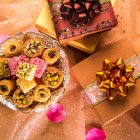 Make Gifting Easy this Festive Season with a Gift Pack: 11 Awesome Ideas for Diwali Gift Packs for 2019
Make Gifting Easy this Festive Season with a Gift Pack: 11 Awesome Ideas for Diwali Gift Packs for 2019
Janmashtami: A Festival Which Is Celebrated with Great Zeal in India!
History and Significance

A significant occasion pertaining to the Vaishnava tradition in the Hindu religion, the day basically involves celebrating Lord Krishna’s life by way of musicals, devotional songs, fasts, night vigil rituals, and festivities. A major festivity in Mathura, Vrindavan, the celebrations are also observed in other parts of India with equal fervor. Devotees get to witness the magnificent opulence joyfully throughout the festivities, and Lord Krishna is honored actively at innumerable Krishna temples and pilgrim spots at midnight till the time of his birth.
Fasting on Janmashtami
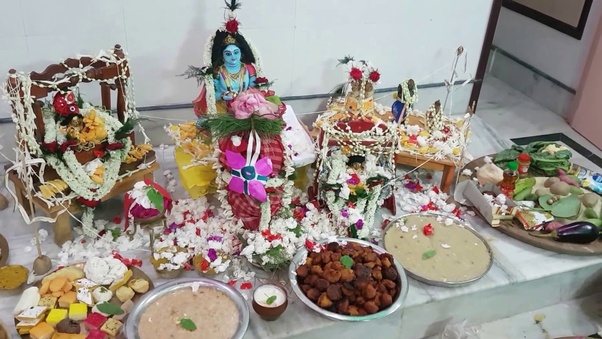
Many people observe a disciplined fast during Janmashtami to honor Lord Krishna’s birth. Delectable sweet treats and mouth-watering delicacies are prepared for offerings and Prasad during the celebrations and eaten after the birthday exuberance. For those who like to keep a fast, it is best to keep the body hydrated with lots of water and fruit juices as this will not only be beneficial for their health but also keep them from getting sluggish.
Drinking water keeps the stomach full and also neutralizes all the acids, boosting the body’s metabolism as well. Eating fruits with a high water content like watermelon/musk melon will keep the body energetic as will bananas or mangoes with a glass of milk. When it is time to break the fast, avoid gorging on heavy meals or fried food as you may end up with indigestion or acidity.
Multiple Ways of Celebrating Festivities

Given India’s diverse cultural heritage, like most other festivals, Janmashtami, too, is celebrated with a lot of excitement, gaiety, and fanfare. With different customs followed in different parts of the country, pertaining to Lord Krishna’s life stories, each region celebrates the festival in their own unique way. For instance, since Lord Krishna was born in Mathura, U.P, it is common to see Krishna Lila (a folk drama) being performed with significant chapters of his life, while in Maharashtra, the festivities are called Govinda where pots of buttermilk are suspended high over the streets and human pyramids are formed in competition to see which team breaks the most pots!
In Tamil Nadu, oiled pots containing money are tied high up, and boys dressed as Lord Krishna climb poles to get these money pots while being squirted with water by the onlookers. Everywhere, all the pilgrim spots, temples, and houses are decorated with innumerable tableaus and images of Lord Krishna with night-long rituals, folk dances, and devotional hymns being sung.
Janmashtami Prasad Recipes
Dhaniya Panjiri
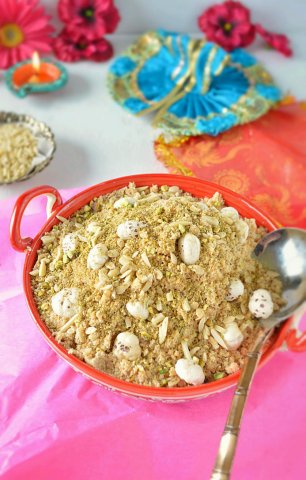
Dhaniya Panjiri’s considered one of the best prasad offerings on the auspicious occasion of Janmashtami. A popular sweet dish, it is made mostly during fasts, takes 10 minutes to prepare for and about 20 minutes to cook.
Ingredients
- 1 ¼ cup Ghee
- 2 cups of Dhaniya Powder
- ½ cup Makhane
- 10 pieces of cashew nuts (crushed)
- 10 pieces of almonds (crushed)
- ½ cup of grated coconut
- ½ cup of powdered sugar.
Method
- Begin by heating a tablespoon of ghee in a pan and fry the cashew & almonds till they become slightly brown. Keep them aside, and in the remaining ghee, roast the makhana till it turns crisp.
- Take it aside and then grind it coarsely. Next, heat ¼ cup of ghee in the pan, add the dhaniya powder, and roast it on low till it turns brown and fragrant, which could be about 8-10 minutes.
- Keep stirring the powder continuously and then add the cashew, almond, and makhane mix to it.
- Stir it well, remove from heat and let it cool down. Once the mix has cooled down completely, add the powdered sugar and grated coconut, mix it well, and your Panjiri is ready for offering.
You can store it in an air-tight container, and it will last for up to a week.
Makhan Mishri

Since Lord Krishna loved eating butter, the sweet dish of Makhan Mishri is known to be one of the most significant Prasad offerings on his birthday.
Ingredients
- A cup of cream (malai)
- 12 ice cubes
- ¼ cup crystallized sugar
- Few pistachios
Method
- Take a bowl and add malai (room temperature), continue by adding the ice cubes to the bowl.
- Blend the cream in a blender till it turns buttery. Continue churning till the cream and its water separate.
- Collect the butter and put it to cool in the refrigerator for about an hour and then add the crystallized sugar along with some pistachio garnish to offer it to Lord Krishna.
Makhana Paag
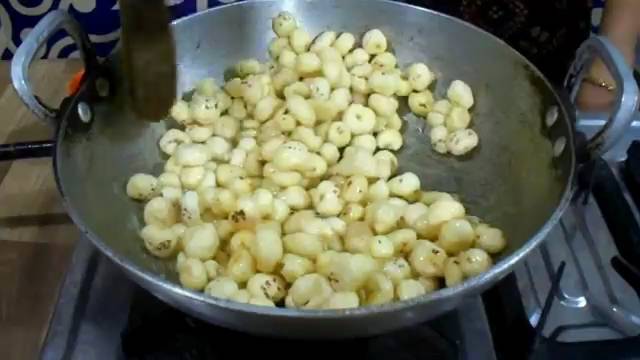
Puffed Lotus Seeds Chikki or Makhana Paag, as it is popularly known, is another delicious sweet dish that’s appropriate for Janmashtami.
Ingredients
- 50 gm of Makhane
- 250 gm Sugar
- 1 tbsp Milk
- 150 gm Ghee.
Method
- Begin by chopping the lotus seeds into small pieces. Heat some ghee in a pan and fry the Makhane till they become light brown.
- Grease a plate with some ghee and transfer the makhane onto the plate. Now put the sugar in the pan with ½ cup water and let it simmer until the sugar dissolves completely, stirring it continuously.
- Then add milk to the liquid mix and strain out the foam on the syrup with a spoon, cooking the liquid till it becomes as uniform as a thread.
- Turn off the flame and add the Makhane to the liquid. Keep stirring it till the sugar syrup cools down, and the seeds get coated evenly.
- After keeping it aside for 15 minutes, take the paag from the plate and cut it into the desired size/pieces.
Panchamrit
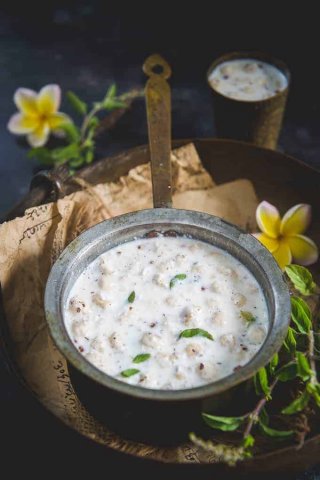
A holy brew made of five holy ingredients, Panchamrit or Charnamrit is known to be the elixir of Gods and is typically used in all Hindu rituals and offerings, tastes sweet and milky. It entails Milk for purity, Honey for sweetness and polite speech, Yogurt for procreation, Sugar or Jaggery for happiness, and Ghee for wisdom and knowledge.
Ingredients
- ½ liter cow’s milk (raw)
- 200 gm curd
- 4 tsp honey
- 10 lotus seeds
- 1 tsp chironji
- 10 tulsi leaves
- 1 tsp Gangajal
- 1 tbsp chopped almonds
- 1 tbsp chopped cashews
- 1 tbsp grated dry coconut
- 1 tbsp chopped raisins
Method
- Just mix all the ingredients in a bowl and keep it in the refrigerator for a few hours .
Kheer
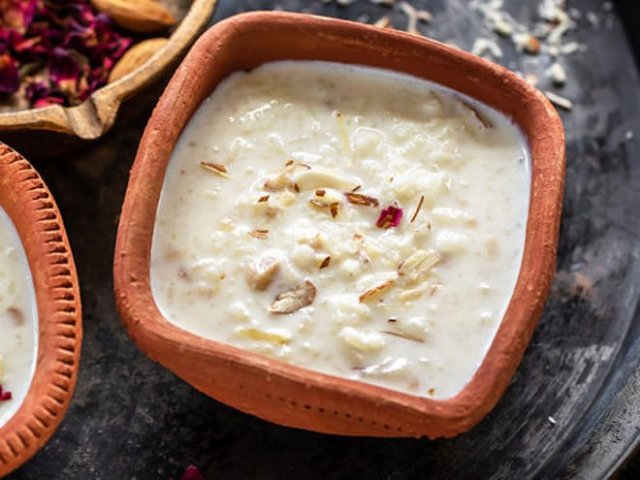
Sabudana or Sago Kheer is quite popular as a sweet dish offering during fasts, celebrations, and festivals and is very easy to make!
Ingredients
- A liter of full cream milk
- ½ cup sabudana
- 15-20 saffron strands
- ½ tsp cardamom powder
- ¼ cup sugar.
Method
- Wash and soak the Sabudana in ½ cup water for about 5 hours.
- Heat milk in a pan, and once it comes to boil, add the soaked sago to it with the saffron strands.
- Lower the flame and let it cook till it attains thick consistency, and the sabudana is cooked, which would be about 40 minutes to an hour.
- Keep stirring it continuously. Add sugar and elaichi powder to the kheer and mix well. Garnish it with almond and pistas.
Janmashtami Festive Recipes
Sabudana Khichdi

Made of Sabudana, Potatoes, and Herbs, Sabudana Khichdi is known as food for the Hindu Fasting and offering rituals.
Ingredients
- 1 cup sabudana
- 2 tbsp peanuts
- 2 tbsp oil or ghee
- ½ tsp jeera
- 1 sprig curry leaves
- 1-2 slit or chopped green chillies
- 1 boiled potato
- 1/3 tsp powdered rock salt
- 2 tbsp coriander leaves finely chopped
- 1 tbsp lime juice
Method
- Wash and soak the Sabudana in 2 cups of water for about 5 hours.
- Dry roast the peanuts till they turn fragrant and golden. Heat some ghee/oil in a pan and add the jeera, chilly, curry leaves and saute for a minute.
- Sprinkle the salt. Mix some salt to the sabudana and mix well, then add this mix to the pan on high flame, stir and saute for a couple of minutes or until it turns transparent.
- Overcooking can make it sticky. Add the lemon juice and roasted peanuts to the sabudana mix and your khichdi is ready.
Dahi Aloo
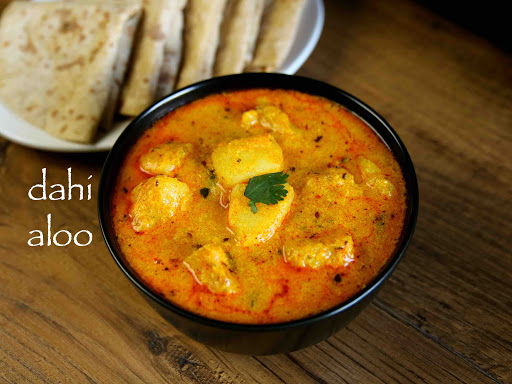
An ideal fasting recipe which is best paired with steamed rice, roti, or jeera rice, Dahi Aloo is prepared with yogurt and other dry spices and doesn’t include any garlic, onion or tomatoes.
Ingredients
- 1 tbsp Ghee
- 1 bay leaf
- ½ tsp haldi
- 1 tsp jeera
- An inch of finely chopped ginger
- ½ tsp dhaniya powder
- 1 slit green chilly
- 1 tsp red chilli powder
- 2 large potatoes (boiled and cut into cubes)
- 1 cup water
- 1 cup curd
- ½ tsp salt
- ½ tsp garam masala powder
- 1 tsp kasuri methi
- 2 tbsp finely chopped coriander leaves
Method
- Begin by heating ghee in a pan and saute the bay leaf with jeera till they become fragrant.
- Continue by adding ginger, chilly and saute well. Now lowering the flame, add the haldi, chilli powder, dhaniya powder and saute for about 30 seconds. Then add water and beaten curd to the mix.
- Stir continuously on low flame till the curd mixes well. Next, add the potatoes to the curd mix with salt, stir it well, cover and simmer for 5 minutes or till the potatoes absorb the flavor.
- Then, add the garam masala, kasuri methi and coriander leaves to the gravy and mix well. Serve it with rice or roti.
Raw Banana Kofta
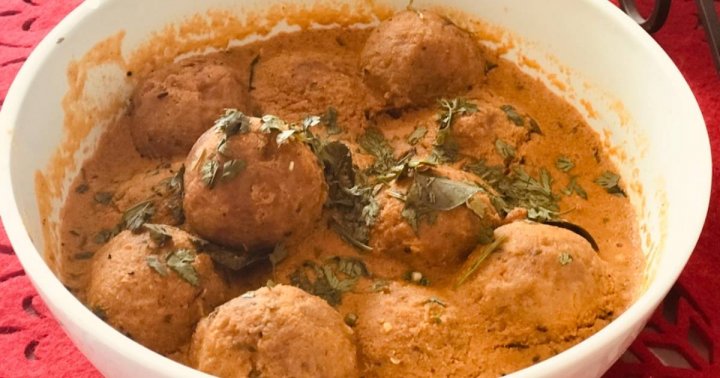
The Raw Banana Kofta is a well-known dish in North Indian cuisine served on special occasions and is best served with Pulao.
Ingredients
- 2 raw bananas (boiled till they become soft)
- 3 tbsps Paneer (grated)
- 1 small and finely chopped onion
- 1 tbsp besan
- 1 tsp ginger and green chilly paste
- ½ tsp dhaniya powder
- A pinch of amchur
- 2 tbsps finely chopped coriander leaves
- salt to taste, oil for deep frying.
Ingredients (For Gravy)
- 1” cinnamon stick
- 1 elaichi
- 1 finely chopped onion
- 1 large tomato pureed
- 1 tsp ginger and green chilly paste
- ¼ tsp haldi
- ½ tsp red chilly powder
- A pinch of jeera powder
- 1 ½ tsps. Dhaniya powder
- ¼ tsp garam masala
- 10 cashews soaked in ¼ milk for 15 minutes and grinded to a paste
- 1 tsp cream for garnish
- Salt to taste
- 2 tbsps oil
- Coriander leaves for garnishing
Method
- Begin by cutting the ends of the bananas and then cutting them into 2 pieces, boil them in 4 cups of water with ½ tsp haldi on low-medium flame for about 20-30 minutes (according to the size of the bananas) or till they turn soft.
- Once done, drain the water and let the bananas cool down, then peel and grate them. Next, add the banana, chopped onions, paneer, ginger chilly paste, dhaniya powder, amchur, besan, salt and coriander leaves to a bowl and mix well and then make small koftas of the mix and keep aside.
- Heat the oil and once ready, reduce the flame to a medium and place the oils gently into the pan for deep frying.
- Fry to a golden brown and then remove the koftas into a bowl atop a kitchen towel to soak in the extra oil. Move to making the gravy now.
- Heat oil in a pan and add the dalchini, elaichi, allowing them to splutter. Then add onions and saute for a few minutes, continue by adding the green chilly and ginger paste, saute for another minute and then add haldi, jeera powder, red chilly powder, salt and mix well.
- Add tomato puree to the mix and continue cooking for another 8 minutes, add the cashew paste next and cook for 3 minutes.
- Next, add 1 ½ cups of water and bring to a boil, reduce the flame and simmer for about 7-8 minutes or till the gravy turns into the required consistency.
- Turn off the heat once done and transfer the curry into a bowl, pouring it over the koftas till they are submerged in the gravy and allow them to sit in for about 10 minutes before serving.
- Garnish with fresh cream and coriander leaves.
Vrat Ki Kadhi
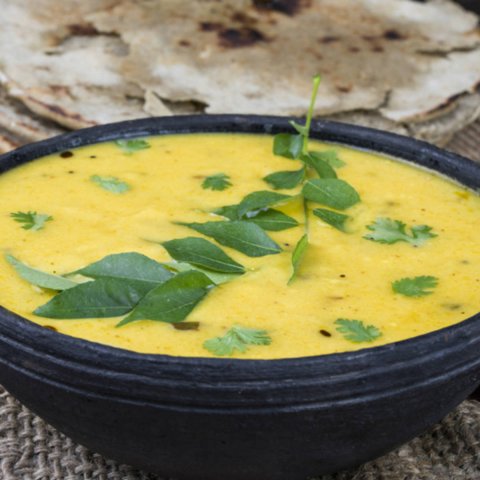
Unlike the normal Kadhi, Vrat ki Kadhi is made of water chestnut flour, yogurt, curry leaves, dhaniya, ginger and few other vrat appropriate spices, best paired with Kutti Puri or Samak Rice.
Ingredients
- Sendha Namak to taste
- 1 ½ tbsp. red chilli powder
- 1 tsp jeera
- 5 red chillies dried
- 1 cup water chestnut flour
- A sprig of curry leaves
- 1 tbsp haldi
- 1 ½ cup yogurt
- 1 tbsp powdered dalchini
- 1 tsp crushed ginger paste
- sugar to taste
- 1 tbsp ghee
- some coriander leaves for garnish
Method
- Begin by taking a bowl and adding the water chestnut flour, dahi, red chilli powder, dalchini powder, and water and mix it all well.
- Next, heat a Kadai and add jeera, red chilly and curry leaves. Saute them till they splutter and then lower the flame.
- Add the curd mix to it and stir well to thickness. Add rock salt, sugar and continue to simmer for about 3 minutes.
- Garnish the Kadhi with curry leaves and chopped coriander leaves.
Sweet Potato Halwa

Ingredients
- 2 medium to large sweet potatoes
- 4 tbsp sugar
- 7-8 tbsp ghee/oil
- 3-4 crushed or powdered elaichi
- A pinch of kesar
- 10-12 chopped cashews
Method
- Begin by boiling the potatoes, peel and mash them and keep aside.
- Next heat some ghee in a pan, fry the cashews to golden color, keep aside.
- Now, add the mashed potatoes to the hot oil, stir well and saute for about 3-4 minutes, add sugar and continue stirring for another 5 minutes.
- Add the crushed elaichi, stir and then add the saffron and stir again. Continue the stirring till the halwa separates from the ghee (which will be in about 10 minutes or so).
- Add the fried cashews to the Halwa and serve.
Tips for Janmashtami Celebrations at Home
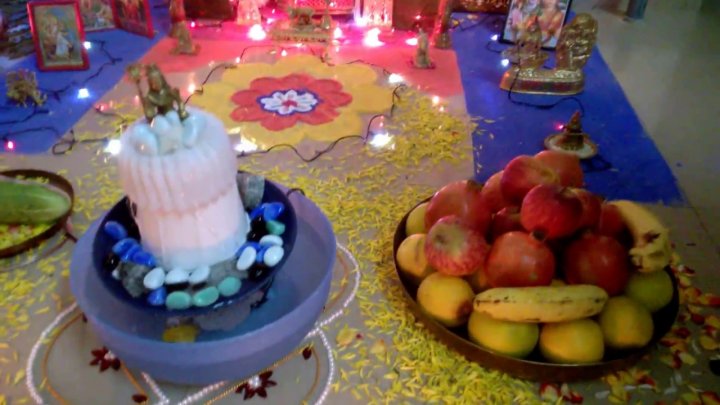
- Fasting – It is one of the most significant aspects of the festivities of Janmashtami, and a fast typically begins at dawn, continuing till midnight. Depending on your lifestyle and health challenges if any, you can observe a fast with consumption of fruits, water and milk.
- Devotional Songs & Chants – These are another essential element of the celebrations that are observed during Janmashtami. You can either participate in singing devotional hymns and chants in a group at your local temple or chant the Hare Krishna Mantra in your own space.
- Decorations & Offerings – Can be arranged in your home and temple with flower garlands, leaf festoons and balloons with an assortment of colours to make it brighter and cheerful. You can dress up your deities in colourful clothes and make an offering of sweetmeats and other festive delicacies as Prasad.
- Reading – From religious scriptures and watching religious reenactments is another significant activity of the festival, especially from the Bhagavad Gita or Gita Puran.
-
 Diwali Snacks You Can Make in Your Kitchen, which Are As Healthy As They Are Delicious! (2021)
Diwali Snacks You Can Make in Your Kitchen, which Are As Healthy As They Are Delicious! (2021)
-
 भारतीयों का मिठाई के लिए एक विशेष झुकाव है: 10 सबसे स्वादिष्ट भारतीय मिठाइयाँ विकल्प जिन्हे देख कर आपके मुंह में पानी आ जायेगा (2019)
भारतीयों का मिठाई के लिए एक विशेष झुकाव है: 10 सबसे स्वादिष्ट भारतीय मिठाइयाँ विकल्प जिन्हे देख कर आपके मुंह में पानी आ जायेगा (2019)
-
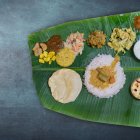 Bring the Flavours of Onam Sadhya to Your Kitchen! List of 10 Onam Sadhya Dishes Which Are As Easy to Make As They Are Delicious to Eat (2019)
Bring the Flavours of Onam Sadhya to Your Kitchen! List of 10 Onam Sadhya Dishes Which Are As Easy to Make As They Are Delicious to Eat (2019)
-
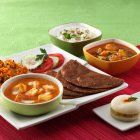 Fasting Does Not Mean Starving! Keep Your Energy Up with These 9 Delicious Navratri Recipes & Fasting Tips for Navratri (2019)
Fasting Does Not Mean Starving! Keep Your Energy Up with These 9 Delicious Navratri Recipes & Fasting Tips for Navratri (2019)
-
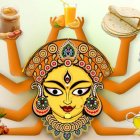 Planning to Fast During Navratri? Here are 9 Quick and Healthy Recipes for Your Navratri Fast in 2019!
Planning to Fast During Navratri? Here are 9 Quick and Healthy Recipes for Your Navratri Fast in 2019!
You Don't Have to Go Out to Celebrate Janmashtami This Year!
While others celebrate Janmashtami at a temple, their homes, or other religious places through fasting, singing, or dancing, you can observe the celebrations and festivities in your own way in the comfort of your home by making a few arrangements that are easy to observe and arrange for.

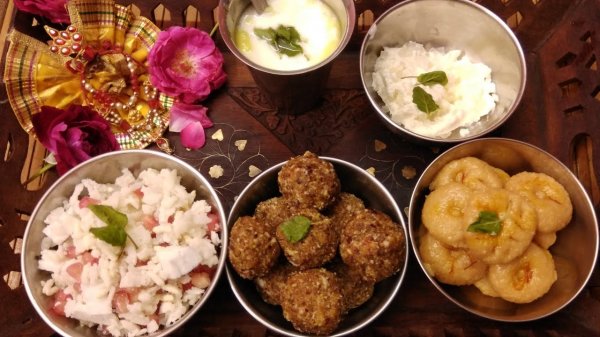
 Highlight the Best Facets of Your Incomparable Beauty: Discover the Best Face Highlighter Currently Available in India and Everything You Need to Know About Using Face Highlighters for Maximum Effect (2023)
Highlight the Best Facets of Your Incomparable Beauty: Discover the Best Face Highlighter Currently Available in India and Everything You Need to Know About Using Face Highlighters for Maximum Effect (2023)
 Forget the Blemishes and Get that Picture Perfect Flawless Radiance on Your Face: Check out the Best Foundations for Oily Skin Currently Available in India and Everything You Need to Know About Makeup Foundations (2023)
Forget the Blemishes and Get that Picture Perfect Flawless Radiance on Your Face: Check out the Best Foundations for Oily Skin Currently Available in India and Everything You Need to Know About Makeup Foundations (2023)
 Make Your Presence Felt Wherever You Go: Discover the Best Perfumes Under 2000 for Both Men and Women to Announce Your Arrival and Make Any Occasion Memorable (2023)
Make Your Presence Felt Wherever You Go: Discover the Best Perfumes Under 2000 for Both Men and Women to Announce Your Arrival and Make Any Occasion Memorable (2023)
 Protect Your Oily Skin from the Harmful Rays of the Sun: Discover the Best Gel Based Sunscreens for Oily Skin and Everything You Need to Know Before Buying One (2023)
Protect Your Oily Skin from the Harmful Rays of the Sun: Discover the Best Gel Based Sunscreens for Oily Skin and Everything You Need to Know Before Buying One (2023)
 Minor Blemishes and Wrinkles Affecting Your Confidence? Check out the Best BB Creams to Conceal Your Worries and Nourish Your Skin to Restore the Healthy, Radiant and Glowing Complexion Back Again (2023)
Minor Blemishes and Wrinkles Affecting Your Confidence? Check out the Best BB Creams to Conceal Your Worries and Nourish Your Skin to Restore the Healthy, Radiant and Glowing Complexion Back Again (2023)
